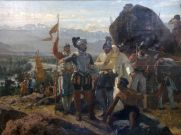Popularizing the Past: Historians, Publishers, and Readers in Postwar America, Nick Witham, University of Chicago Press, 2023, pp. 220, $25.00 paperback.
It is no secret that the current study of history in American higher education is fraught with problems. Enrollments in history courses have plummeted over the past couple of decades, and, not surprisingly, jobs for freshly minted Ph.D.’s have become increasingly scarce. The percentage of bachelor degrees awarded history majors is currently the lowest on record extending back to the late 1940s. Many of the factors responsible for this predicament, such as the allure of computer science, are beyond the control of academic historians, but there is little doubt that some of these factors have been self-inflicted.
The irony is that despite the diminished role of history in academia, the public continues to have an intense interest in history in general and American history in particular. Commercial films on the American Revolution, the American Civil War, World War II, the Vietnam War, and American politics attract large audiences; the Broadway musical “Hamilton” has been a huge box-office success; visitors in great numbers flock to Civil War battlefields and other American historical sites; historical topics such as whether military bases should be renamed and the morality of dropping the atomic bombs in August, 1945 are hotly debated; there are cable television channels devoted to history in general, military history, and American heroes; and the books of non-academic historians such as Rick Atkinson, Robert A. Caro, Bruce Catton, Ron Chernow, Doris Kearns Goodwin, William McCullough, and Barbara Tuchman have attracted a wide audience.
In view of this widespread interest in history, why is academic history in such a sorry state?
Nick Witham’s Popularizing the Past is both an analysis of this problem as well as a symptom of it.1 A professor at University College in London specializing in American history, Witham examines the most significant books of five prominent American historians of the mid to late twentieth century: Richard Hofstadter (Columbia University), Daniel J. Boorstin (University of Chicago), John Hope Franklin (Duke University), Howard Zinn (Boston University), and Gerda Lerner (University of Wisconsin). Left out of this discussion are American historians such as Bernard Bailyn (Harvard), Oscar Handlin (Harvard), Perry Miller (Harvard), Edmund Morgan (Yale), C. Vann Woodward (Yale), David M. Potter (Stanford), and Gordon Wood (Brown), all of whom were probably more influential in shaping American historiography during this era. So why these five?
Witham chose the five because, although they ranged widely “across issues of politics, culture, race, and gender,” they all used the writing of history to propagate a political agenda and to challenge the political status quo. (10) Whether, in fact, the five provided an accurate reading of the past is outside Witham’s scope and appears irrelevant to him. For him, politics supersedes the impartial search for truth, and what is important is not the past itself but how the examination of the past can be used by historians, particularly those with political axes to grind.
Witham argues that, “All popular historical writing was inherently political,” and his five historians “were deeply political, and this fact indelibly shaped the books they wrote. Consequently, they conceptualized good popular history not simply as entertaining or well researched, but also as politically relevant.” (203, 165)
Like Aaron’s staff, Popularizing the Past would have politics swallow up everything about the past. If one is looking for reasons why over the last forty-five years the number of history majors at Harvard has declined from around 150 to under fifty, with similar declines afflicting Columbia, Swarthmore, Williams, Wellesley, and other elite institutions,2 it’s a good bet that the politicization of the historical record by Witham and others of his ilk has played a prominent role.
Indeed, Witham’s decision of focus on the politics of historians requires him to ignore some of the most exciting aspects of post-World War II historiography. This includes the introduction of new methodologies and topics such as psycho-history, cliometrics, and the new social history. Undergraduate and graduate students of the 1950s and 1960s—I was one—were entranced by psycho-biographies of Martin Luther, Adolf Hitler, and Woodrow Wilson and speculated as to whether the use of statistics as a research tool could deepen our understanding of the past. We also wondered about the influence of ethnicity and religion on America’s history. This was especially true for those of us who were in graduate school in New England where immigration had been particularly important, and where the division between the native-born and immigrants was sharply drawn.
The initial chapter of Popularizing the Past focuses on Richard Hofstadter’s 1948 volume The American Political Tradition and the Men Who Made it, his most political and acerbic work. Its narrative of American politics from the Founding Fathers through Andrew Jackson and Abraham Lincoln and then on to Franklin D. Roosevelt exhibited Hofstadter’s strong antipathy to the dominant American political ideology in which individualism, free enterprise, the sanctity of property, and distrust of centralized government loomed large.
But The American Political Tradition was hardly Hofstadter’s most significant volume. Hofstadter began as a man of the Left and briefly during the 1930s belonged to the American Communist Party. After the publication of The American Political Tradition however, he took a more critical stance toward left-wing politics, and by the 1960s was a caustic critic of the moralism and destructiveness of the New Left.
In 1956 he won his first Pulitzer Prize for The Age of Reform: From Bryan to FDR, his most controversial and influential book. His dissection of the reformist impulses of the early twentieth century prompted numerous rebuttals by other historians, and these resulted in a productive re-examination of the Progressive era. Particularly noteworthy was Hofstadter’s use of social science in explaining populism and progressivism. The Age of Reform is replete with talk of status anxiety, paranoia, psychological projection, and other concepts derived from sociology, depth psychology, and the role of myths.
By the mid-1950s Hofstadter had moved significantly away from the simplistic economic interpretations offered by Marxists and the prominent Columbia historian Charles A. Beard.3 He would dissect Beard in his 1968 volume, The Progressive Historians: Turner, Beard, Parrington. this time Hofstadter had also published histories of American anti-intellectualism, violence, and academic freedom, none of which are discussed by Witham. These important volumes are of tertiary importance for Witham because they seemingly had little connection to Hofstadter’s chief objective which, Witham claims, was always “to use popular historical writing to intervene in contemporary political debates on behalf of radical social change.” (42) It is questionable whether Hofstadter’s wide-ranging mind should be placed in such a narrow pigeon-hole. In 1965, for example, he won a second Pulitzer Prize for Anti-Intellectualism in American Life, a book which hinted strongly at Hofstadter’s skepticism of radical social change and which blamed populism, in part, for the nation’s anti-intellectualism and susceptibility to authoritarianism.
Witham believes that politics was also high on the agenda of Daniel Boorstin, but in his case not left-wing radicalism but a “rapidly evolving and outspoken intellectual conservatism.” (67) Boorstin was an active member of the Republican Party and was appointed by Republican Presidents to direct the National Museum of History and Technology of the Smithsonian Institute and then the Library of Congress. He wrote over twenty books, the most famous being a trilogy chronicling American history from the colonial period through the twentieth century—The Americans: The Colonial Experience (1958), The Americans: The National Experience (1965), and the Pulitzer Prize winning The Americans: The Democratic Experience (1973).
Witham’s analysis of Boorstin focuses on the trilogy. He describes it as “patriotic boosterism,” “a deviation from the liberal norm,” and a celebration rather than a critique of America’s past. (67-68) Boorstin, Witham claims, was a “Cold War conservative,” a Burkean conservative, and a critic of liberal ideological fanaticism. Witham does not discuss Boorstin’s other trilogy which analyzed the inventiveness and impulse to discover within Western culture—The Discoverers: A History of Man’s Search to Know His World and Himself (1987), The Creators: A History of Heroes of the Imagination (1992), and The Seekers: The Story of Men’s Continuing Quest to Understand the World (1998).
Witham’s attempt to fit Boorstin’s literary oeuvre into a conservative political straightjacket, as with his discussion of Hofstadter, does not do justice to Boorstin’s capacious mind and varied interests. Thus, there is no discussion of Boorstin’s The Image: A Guide to Pseudo-Events (1962), an imaginative examination of the role that advertising has played in promoting pseudo-events and what later would be called “fake news.”
Witham’s third historian is John Hope Franklin, the leading black American historian of the latter half of the twentieth century and author of From Slavery to Freedom: A History of American Negroes (1947), the most influential and widely read survey of America’s blacks. Franklin died in 2009, and during his lifetime the book had sold more than three million copies and was translated into Chinese, French, German, Japanese, and Portuguese. As Witham notes, it had become “a staple of university classrooms around the world.” (102)
From Slavery to Freedom, Witham notes, was a “bastion of racial liberalism,” and its title reflected Franklin’s confidence that blacks were on the verge of overcoming the disabilities of racism and segregation. (85) The defeat in 1945 of racist Nazi Germany, two years before the publication of From Slavery to Freedom, was seen as a decisive factor in bringing the campaign against racism in the United States to its apex in the 1964 Civil Rights Act.
Franklin, who had received a Ph.D. in history from Harvard, was a committed integrationist and a racial meliorist. He believed blacks were simply people who “happened to find themselves in the United States with an as-yet-unfulfilled desire to participate fully and equally in the mainstream of American life.” (97) They were Negroes, not Afro-Americans and certainly not blacks, a term that Franklin viewed as pejorative. He opposed the various forms of Black Nationalism and defied black revolutionaries. This earned him the enmity of Vincent Harding, Harold Cruse, and other black militants.
Witham is on the side of Franklin’s critics on the Left, and he describes Franklin’s skepticism during the 1990s regarding Black Nationalism as “outdated.” “Many of his readers did not view him as an altogether benevolent force in their intellectual upbringing,” Witham says. “Instead, they grappled with, revised, and sometimes rejected his ideas, using them to clarify their fundamental understandings of racial identity and political activism.” (102) Here, as elsewhere, Witham refuses to make any judgment regarding who had a better understanding of the history of black Americans, Franklin or his critics. But there is little doubt where Witham’s sympathies lie.
This was true also of Witham’s fourth historian, Howard Zinn, the author of the best-seller A People’s History of the United States (1980). Zinn was less a careful historian than a chronicler of the grievances of various marginalized American groups and individuals: Native Americans, blacks, women, immigrants, gays, and the like. Michael Kammen, a prolific Cornell University historian, described A People History as “simple-minded history” and Oscar Handlin, the dean of American social historians, said it had “the deranged quality” of a “fairy tale.” Even Michael Kazin, an historian of the Left, believed A People’s History to be “bad history,” a “Manichean fable” and a disservice to the Left for over estimating the hold that the rich and powerful have had on the American economy and politics. (124)
Witham does not comment as to the accuracy of such criticisms, but when it comes to the politics of history he is on Zinn’s side. He accuses Zinn’s critics of being simplistic and intolerant of criticisms from the Left, when, in fact, they had reasonable concerns with Zinn’s historiography. The significance of A People’s History, he concludes, was not whether it provided an accurate portrait of America but rather its peculiar ability to provide emotionally charged history for those suspicious of America’s legitimacy and “to intersect radical politics and American history, approaches to education and the culture wars, and the ways in which history could be popularized among young audiences seeking alternatives to the ‘mainstream.’”
Again, there is no attempt by Witham to evaluate Zinn’s work based on traditional historical standards. It is sufficient that he wrote politicized history.
Finally there is Gerda Lerner, the subject of Witham’s last chapter. Lerner, a political radical, was a pioneering feminist historian of the latter half of the twentieth century and the author of two foundational texts within feminist historiography, The Creation of Patriarchy (1986) and The Creation of Feminist Consciousness (1993). Witham claims that Lerner “demonstrated to the world that women’s history could be rigorous, political, and readable in equal measure.” (135) Even when pitched at high school students, “her vision of popular history was highly politicized.” (144) But there is no discussion of whether this highly charged politicized history was also accurate.
For Lerner and for feminist historians generally, the most important factor in history has not been class, race, or nationality but gender, and history was indispensable in raising the consciousness of women and emancipating them from the tyranny of the patriarchy. Only a history concerned with the passing of patriarchy, she wrote, “can claim to be a truly universal history.” (147) Witham does not discuss whether gender in fact has been as important as the feminists argue, preferring instead to take their claims at face value.
Judged by the title that Witham chose for his book, he equates “popularizing” history with politicizing it. There is little that threatens the credibility of history or undermines its popularity more than when its practitioners are seen to have political axes to grind. This transforms history into propaganda. And since the reading public contains people with diverse political outlooks, the appeal of any politicized history will necessarily be limited.
Publicity for Witham’s volume noted that his five historians believed engaging politically with their reading public was “a vital part of their postwar identity and mission.” While this was occurring during the 1960s, young radical historians were calling for a “new past” which would be more politically relevant.4 But far more beneficial than a new past would have been a true past.
Unfortunately, the type of history favored by Witham is currently in favor. Reviews of his book have been positive, particularly the lengthy one by Christopher P. Loss of Vanderbilt University, which appeared in December, 2024 in the quarterly journal Reviews in American History.5 Loss called Popularizing the Past a “penetrating study of history writing,” praised its focus on the politics of its five historians, and noted that it ‘brilliantly lifts the veil on the writing lives of its subjects and how the evolving marketplace of print shaped their literary aspiration.” While the book illuminates the problems facing a profession in crisis, Loss is skeptical that these will be overcome without changing the way history is taught in secondary school and in college. This will require that such teachers be committed to valuing history for its own sake rather than using the classroom to spread the latest political orthodoxy.
Edward S. Shapiro is professor emeritus of history at Seton Hall University; [email protected]. He is the author of A Time for Healing: American Jewry Since World War II (1992), Crown Heights: Blacks, Jews, and the 1991 Brooklyn Riot (2006), A Unique People in a Unique Land: Essays on American Jewish History (2022), and the editor of Letters of Sidney Hook: Democracy, Communism and the Cold War (1995). Shapiro’s “Loury’s Dilemma,” a review of Glenn C. Loury’s memoir Late Admissions: Confessions of a Black Conservative, appeared in our Winter 2024 issue.
1 For the history of academic historians in America, see Marcus Cunliffe and Robin D. Winks, eds., Pastmasters: Some Essays on American Historians (N. Y.: Harper and Row, 1969); Michael Kammen, ed., The Past Before Us: Contemporary Historical Writing in the United States (Ithaca, N.Y.: Cornell University Press, 1980); John Higham, History: Professional Scholarship in America (Baltimore: Johns Hopkins University Press, 1989).
2 David Kaiser, A Life in History (Watertown, Mass.: Mount Greylock Books, 2018), 375-76.
3 Hofstadter was not alone. See in particular Robert E. Brown, Charles Beard and the Constitution: A Critical Analysis of “An Economic Interpretation of the Constitution of the United States” (1956) and Forrest McDonald, We the People: The Economic Origins of the Constitution (1958).
4 See for example Barton J. Bernstein, ed., Towards a New Past: Dissenting Essays in American History (1968).
5 Christopher P. Loss, “Historians on the Market,” Reviews in American History, 52 (December, 2024), 287-97.
Photo by Mick Haupt on Unsplash














